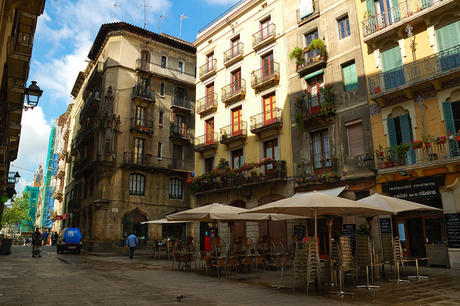La Ribera
La Ribera neighbourhood is a must for anyone taking a walk through Barcelona. Whether you get there from the Via Laietana or the Arc de Triomf, as you explore the maze of narrow streets in this neighbourhood where merchants, artisans and guilds once, you’ll discover the city of design, leisure and fashion.
The full name of La Ribera is Sant Pere, Santa Caterina i la Ribera. La Ribera is found between the Barri Gotic (Gothic Quarter) and Parque Ciutadella. La Ribera is divided from Barri Gotic by Via Laietana.
La Ribera is one of the areas of the quarter of Sant Pere, Santa Caterina i la Ribera of Ciutat Vella ("the old city") of Barcelona. Many of the buildings date from late Medieval times. It was a well-to-do quarter during 13th-15th centuries, when it really was by the sea shore, and the area that today is named Barceloneta was still an island. Notable buildings are the Basilica de Santa Maria del Mar and the palaces along Carrer de Montcada, including the Museu Picasso, the Museu Barbier-Mueller d'Art Precolombí, and part of the Textile Museum. Another place of interest is the Fossar de les Moreres, the site of a mass grave of Catalan soldiers fallen during the siege of 1714, which ended with the fall of Barcelona and the end of the War of the Spanish Succession. Part of the quarter of La Ribera was demolished after the War of the Spanish Succession to build a military citadel to punish the defeated city.
The lower section of the La Ribera district, just below Carrer de la Princesa, and leading to Barceloneta is referred to as El Born after the 19th century market on carrer del Comerç that dominates the area. This is one of the trendiest and most touristic districts in the old city. It is a popular place for expats and contains many art boutiques, bars and cafés.
La Ribera, to the left of Via Layetana as you head down towards the port, has its origins at the time when the old medieval centre of Barcelona started to get too cramped. The narrowness of La Ribera's streets even today are witness to the fact that it too was originally built in late medieval times.
The northernmost part of the quarter, La Ribera proper and Sant Pere, in contrast to El Born, is not that touristic, even though it's between Arc de Triomf and Via Laietana, and actually constitutes a much poorer area with a larger number of migrant workers. It is being revitalised, but as with many other instances of urban development in Barcelona, the process has been ethically contested. The Forat de la Vergonya area, near Santa Eulàlia Cathedral, is such an example. The Biblioteca Francesca Bonnemaison is a cultural institution of the neighbourhood.
Many artists have set up their studios in La Ribera neighbourhood, inheriting the past of the neighbourhood where Barcelona city’s artisans used to live. Many street names remind us of the ancient trades and skills: Mirallers (mirror makers), Sombrerers (hatters), Argenters (silversmiths), etc. Streets that grew up around the church of Santa Maria del Mar, which is, without a shadow of a doubt, the masterpiece of Catalan Gothic architecture.
By the 13th century, Barcelona needed to expand beyond its city walls and a separate borough was created, which soon became the district where merchants and the wealthiest Barcelona families came to live, supported by an important seafaring tradition. Carrer Montcada, currently the home of art galleries and major museums such as the Museu Picasso, formed the centre of this affluent part of Barcelona. The medieval palazzos are a vivid reminder of this past. A period of splendour cut short in the 16th century, and later, by the War of the Spanish Succession, when Philip V built a military citadel on the eastern side of La Ribera.
Now, among the ancient stones of La Ribera, restaurants, wine bars, cocktail lounges, dance clubs and designer boutiques showcase the vibrant colour of an old neighbourhood whose beauty has been renewed.
A nice way to get to know La Ribera is to start just above the Barceloneta, on Av. Marqués de l'Argentera, and work your way up into medieval Barcelona.
Carrer de Vidriera meets Av. Marqués de l'Argentera a few blocks west of the Estació de França train station. Follow it north to the Placeta de Montcada and you'll find the church of Santa María del Mar, considered the purest example of Catalan Gothic architecture.
Carrer de Montcada, which meets the Placeta de Montcada on its northeast side, was built in the 14th century as a direct path from the maze of Barcelona's medieval streets to the sea. Head north up Montcada and you'll find yourself transported to the historical stomping grounds of Barcelona's high society. Five of the street's many 14th century palaces, numbers 15-23, are linked together to house the Picasso Museum, Barcelona's most visited attraction with a rare collection of the artist's early works.
Continuing up Via Laetana - El Born's western border just a few blocks from the Picasso Museum - will lead you to the Palau de la Música Catalana, Domenech i Montaner's classical music concert hall. Head east towards the Arc de Triomf, another of La Ribera's modernista structures, and you'll find yourself just above the Parc de la Ciutadella. The Ciutadella contains the Barcelona Zoo and Geology Museum, and is the biggest patch of green in the city center.
This area is to the right of the Barri Gotic area and just above El Born area. This area has "old town" architecture with narrow winding streets and tall old buildings. The area does not have much in the way of tourist attractions but it does offer ready access to the city centre which is a short walk away. You can get there via direct flight to Barcelona or to Girona, Reus or Lleida–Alguaire.




